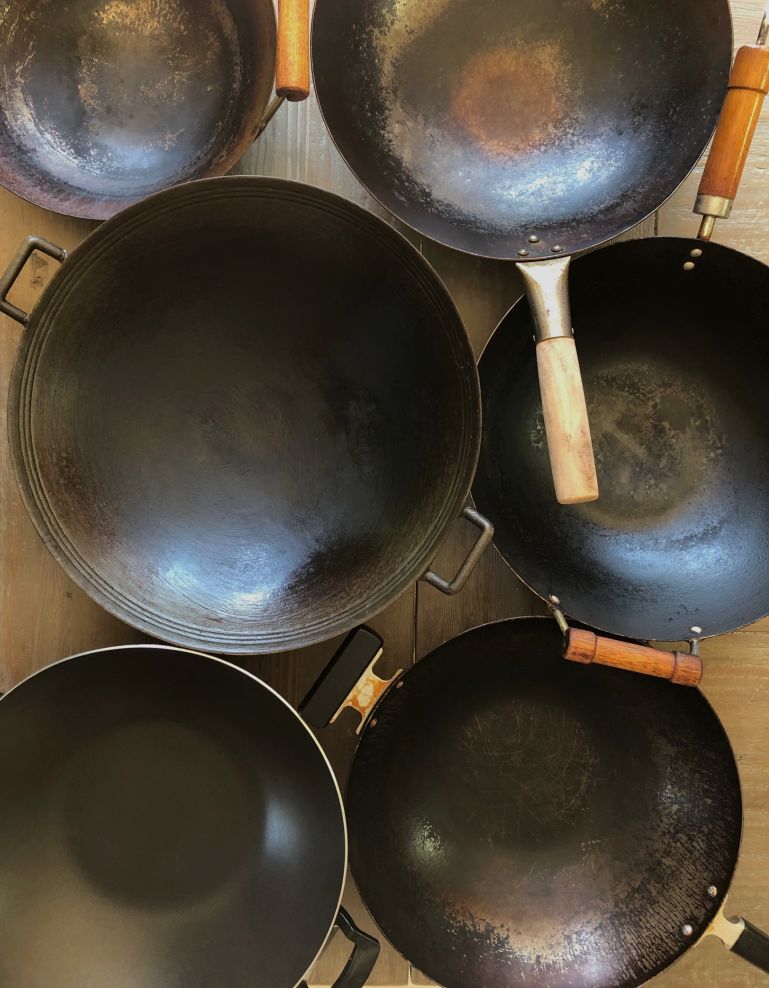
Look in my cupboard, pantry and garage and you'll count six woks. I’ve been cooking with a wok for over 20 years but my relationship with the Chinese cooking vessel started out rocky. My first three were duds – a weak vintage electric Yan Can Cook charmer, a nonstick version whose Teflon coating flaked off, and a carbon steel one that only got sticky and gummy.
I felt like a failure. Countless people rely on woks for their everyday cooking. What was I missing? Around 2005, after reading Grace Young’s The Breath of a Wok, I gave the pan another try, scoring a $20 deal on a flat-bottom Joyce Chen carbon steel wok.
Wok for that Patina
I followed Grace’s instructions in the book to wash, season, and frequently use my wok to build its patina and nonstick interior. Things stuck for months, but I remained determined. I scrubbed the wok as soon as it was emptied of food, drying it on the stove, and occasionally re-seasoning it with oil. The wok slowly changed, sometimes darkening and sometimes lightening, depending on what had been cooked in it.
I stir-fried and deep-fried in the wok to help its natural metal crevices drink in oil. I avoided steaming food in the pan because it removed some of my hard-won patina.
Also, I learned patience. For example, cooking in smallish batches is better than dumping in a ton of ingredients, which cools the wok and turns its satisfying sizzle into a sad fizzle. After two years, the interior was dark and practically nonstick. I fearlessly fried up crispy-edged eggs. Crusty wok-fried potatoes, pan-fried noodles or fried rice? No problem.
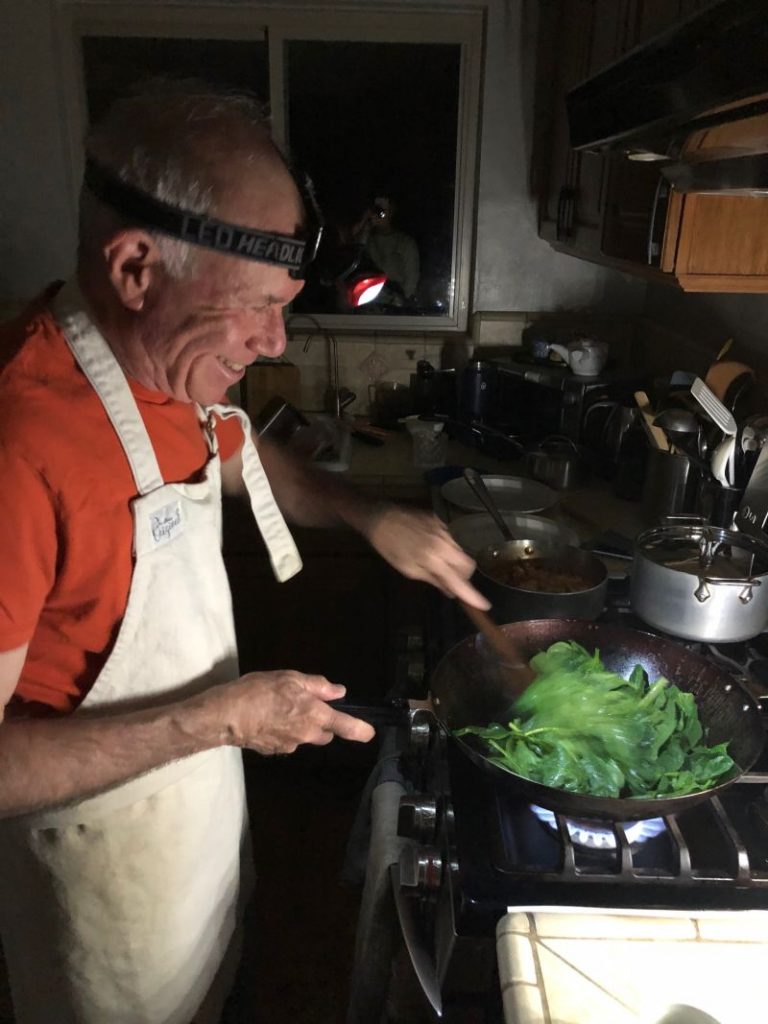
That wok worked well but frankly, it didn’t get hot enough to achieve wok hay (the special seared taste of stir-frying). After falling for heavy French carbon steel skillets, I realized that my beloved wok was a poor heat conductor made of thin metal. I went wok shopping.
Finding a Wok that Works for You
Traditional woks cost $20 to $50 each! Round and flat-bottom woks work great on gas stoves. If your stove is electric or induction, choose a flat-bottom pan so it will have maximum contact with the heat surface.
As for material, skip weak Teflon. Choose carbon steel and look for metal that's described as 14 or 15-gauge, 1.8 to 2.0 mm thick — which signal construction from “heavy” metal. Below are two heavy, thick carbon steel woks from my kitchen. (There are wok shopping sources at the end of this post.)
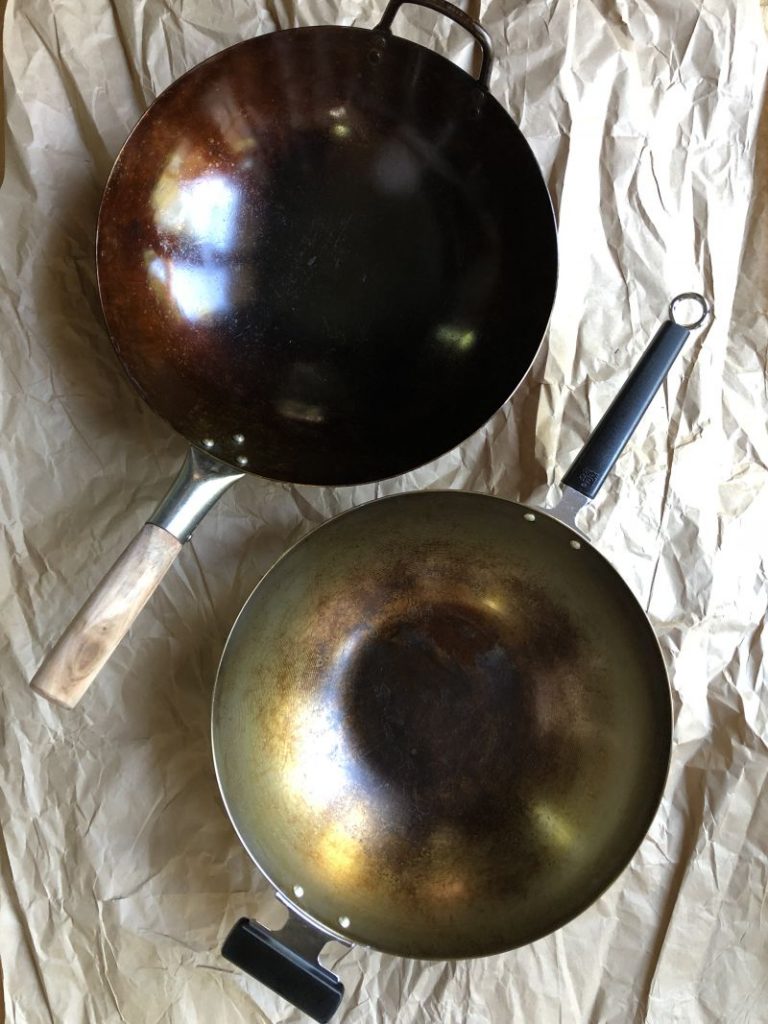
Or, go for lightweight traditional cast iron, which is very thin; heavy cast iron woks are unwieldy for tossing food around and take too long to heat. On the left, a traditional cast iron wok, after 3 months of use. It is my favorite wok. I love the sound it makes when I’m cooking. On the right, my 15-year-old thin carbon steel wok, patinaed after many wokking adventures.
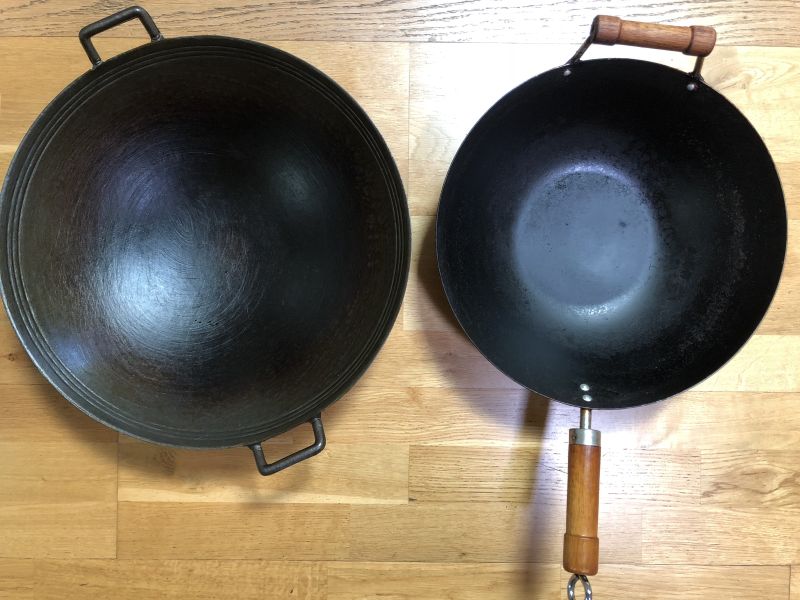
Size-wise, 14-inch-wide woks are standard. But if you can store a bigger, 16-inch-wide wok, you'll find that the extra space liberates you to cook more food and with extra flair. I have a 12-inch wok that's great for deep-frying, though that's a task you can do in a 16-inch one too!
Long and/or small handles? A wok with a long handle and helper handle is easy for swirling oil and dishing out food. If your wok only has two smaller handles, keep pot holders nearby.
My 4 Wok Research
For my recent wok shopping and research, I bought four: two were heavy carbon steel and two were lightweight cast iron. I chose Westernized flat-bottom and old-school round-bottom woks made of each type of metal. (See the end of the post for my shopping sources.)
What I discovered rocked my wok world. Compared to my old thin wok (above), the new heavier carbon steel ones took longer to heat. But once hot, they remained very hot and dynamically sizzled food.
The cast-iron pans looked flimsy but heated faster, held their heat, clanged during stir-frying, and seared food very well. Because the pan walls on all the woks were hotter, I could bank ingredients on their sides to cook on the extra surface area.
A Wok Ring Hack
Changing metals helped, but the wok ring was pivotal. If you have an electric or induction stove, a wok ring won't work.
I own a gas stove, and the wok ring — whether it was a thin metal one or a heavy cast iron wok ring proved ineffective. The ring held the round-bottomed pans in place but whether flipped upside down or right side up, with or without the burner grates in place, it neither sat high enough or low enough for the flames to touch the bottom of the wok. I needed to raise the ring just enough. This is due to the grates being relatively high.
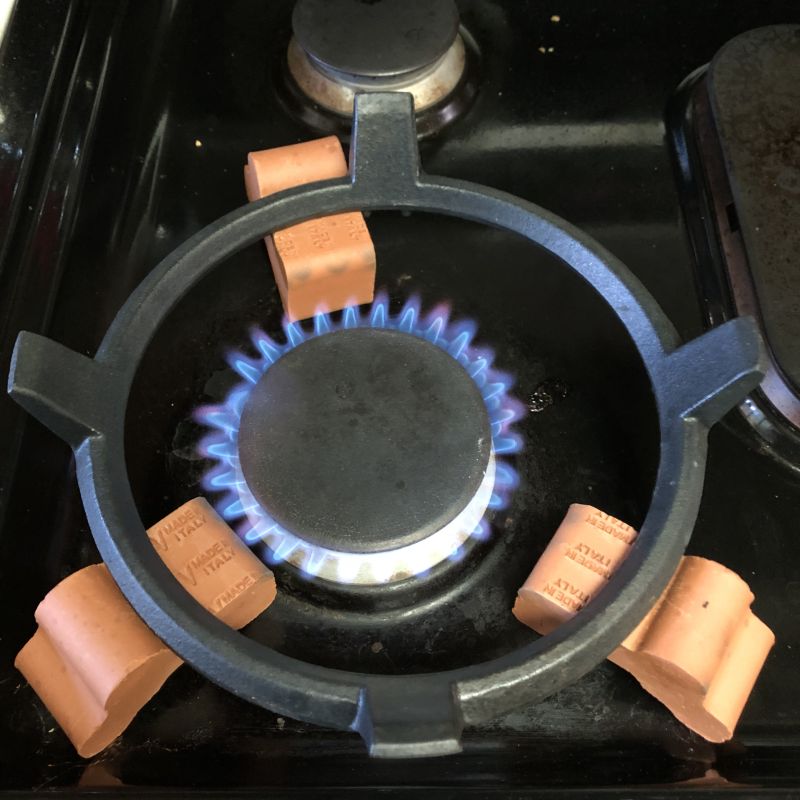
The solution came from our garden: a set of three terracotta pot feet. (You can buy them at garden supply shops or home improvement stores.) The heavy cast-iron wok ring sat steadily on the feet better than the thin metal one; plus, flames shot out of the vent holes and the metal heated too hot and scary.

With the grates removed, and the feet positioned as a triad around the burner with the wok ring on top, I hit pay dirt: the flames licked the wok, making the pan even hotter. My stir-fries sizzled louder and cooked a little faster. Vegetables cooked to a crisp tender with vibrant flavor and color—extra deliciousness.
The wok ring hack boosted performance for round and flat-bottom woks, carbon steel and cast iron alike. I got wok hay all the way. Here's a Food and Wine video on how the wok hack works for shaking beef (bo luc lac), one of my favorite recipes in Vietnamese Food Any Day.
Like a good wok, I’m finally seasoned enough to make them my reliable friends. Decades later, we’ve entered a new phase in our relationship, one that will last forever.
Where to Buy Woks and Wok Rings
I sourced the four woks tested for this post from:
The Wok Shop: I went to the store San Francisco's Chinatown, but you can shop online at their site. You may call the Wok Shop and they’ll consult with you on your needs.
- Round-bottom cast iron wok: The one I purchased is 16-inch wide and weighs 3.5 pounds. I love this wok for its dependable hot sizzle. But it can be awkwardly large for some home cooks. Plus, it required a good wok ring. But it's sturdy, despite its thin construction.
- Flat-bottom cast iron wok: This one was also 16-inches wide and weighed in at 3.5 pounds.
- Basic wok ring: This is a thin metal $2.95 item. It got hot and turned reddish, with flames shooting out the holes. I didn't like it as much as the cast-iron wok ring below, which costs more.
Amazon: I wanted to see what Prime would deliver in case you're not near a superb source.
- Round-bottom carbon steel: A hand-hammered pan by Craft Wok that weighs 4.5 pounds. It's gorgeous and gets hot and sounds super. The weight, with food in the pan, is something you should consider before buying. I do love the wok beast.
- Flat-bottom carbon steel wok: This is the Joyce Chen pro, which weighs 4 pounds, and made from heavy gauge material. This is fine if you don't want to get a wok ring. However, it works extra well with the wok ring and terracotta feet hack! (2020 update: JC is now offering what looks like the same wok but with special teflon coating. I trust the JC company to not sell a product that will flake under duress.)
- Cast iron wok ring: I own a wok ring made by Whirlpool. It's no longer available on Amazon so I've linked to one that looks very similar. When used in the hack with the terracotta feet, the make and model of the stove does not matter. There are other cast-iron wok rings sold so check with your stove.
Note that any links to Amazon on this website are affiliate links. I earn a small referral fee, which I put back into maintaining this site. Thanks for the support.
Wok Seasoning Tips and Recipes
- How to Season a Wok? Here are 3 options to consider
- 9 recipes for you to get into your wok (a fun roundup to get you wokking like a wokstar!)

















Dan says
So glad you recommended Wok Shop. We walked on Grant like tourists in 1988 and found Ms Chan store. It was a revelation. In those days she didn't have Internet so her email orders were received by a friend down the street. When we moved away from California, she was willing to ship to us in Europe. She always added something extra to the order and to this day I have extra wooden spatulas and spoons. So nice to see how her business has survived. Especially on expensive Grant Ave!
Bear says
I bought my first wok from Ms. Chan's The Wok Shop quite a few years ago and loved it , however, at the time, she did not offer a "male" wok without a helper handle. About a year ago I bought a restaurant style pow wok with a welded steel handle and it chows everything I can throw at it. For heat, I use a portable 15,000 BTU butane burner or a charcoal starter chimney (turn it upside down and load 6-8 briquets in it, light and let the fun begin). The chimney also makes short work of the initial burn off of the storage oil and seasoning due to the concentrated heat.
Andrea Nguyen says
Love this intel, Bear!!!! Male vs. Female wok. This is a cooking tool with personality.
Joyce says
Thank you for this! I’ve been working hard at building the patina in my Joyce Chen carbon steel wok. What are good tools to use with it when cooking to avoid scratching the surface? How is it that most Chinese wok tools (wok chan) are metal?
Andrea Nguyen says
I use wood, bamboo, or a curved metal spoon. I agree that the Chinese wok tools are sharp. I've seen professional chefs use ladle like tools for wok cooking.
Marion Rollings, PhD says
What a great wok review! I have a small 12” Teflon wok that I don’t use because I kiss my old 16” wok that I unfortunately got rid of when i moved. I bought the craft hand hammered carbon wok on amazon plus the wok ring you recommended. What a beautiful wok! Heading to Big box store to buy the clay feet for the ring. Thank you for how easy you make things for people like me who have a lot of cooking plans and little time
Andrea Nguyen says
Hooray! I hope you enjoy using your new cooking tools!!!
Kristine says
The Wok Shop is a national treasure. I've gotten so much advice as well as first-rate products. When my daughter got her own place, I called from 1500 miles away, answered a few questions about her stove & what she likes to cook, & voila, the perfect wok arrived. I think it was about $20. Wish I'd had your tutorial, tho!
My stove came with a wok ring, but I've never been happy with it. Thanks for your good ideas about adjusting it!
Naomi says
I love your information about using a cast iron wok ring. Although I have an electric coil stovetop, I wanted to use my portable butane gas stove on the patio to fry things in my wok. It’s one of those gas grills that Asian households seem to have for making hot pot dishes at the dining room table.
I was looking around Amazon,com for a cast iron wok I ring and I found this:
https://www.amazon.com/Vaorwne-Support-Cookware-Universal-Accessories/dp/B07Y99GM9B/ref=sr_1_4?keywords=Vaorwne+Wok+Pan+Stand+Support+Rack+Cast+Iron&qid=1573702443&sr=8-4
It looks like the one you linked to in your post above. The listed dimensions seems the same but about half the price. I ordered it but delivery is in 3 - 6 weeks (although it usually is much less than that). We’ll see how it works out.
Now, I just need to get those terra-cotta pot feet!
Andrea Nguyen says
I think that's the one. It's frustrating sometimes. The feet are easier to get! I spent about $5 at Home Depot, I think.
The butane burner is a great idea! May you wok up wondrous dishes!
Cathy Wallace says
Can you advise if it's better to use a flat bottom or round bottom on a gas stove. I use natural gas on a new GE Profile stove. Thanks. And would I need to purchase a wok ring for whichever style. Thanks.
Andrea Nguyen says
I would go with a flat bottom wok for a gas range so you wouldn't need the wok ring, especially if your new range has a big booster burner. I've found that with my new Cafe range, the flat bottom is fine. I do like using the round bottom wok and put the cast iron ring in place. On the new stove, the terracotta feet have not been necessary. So, you have to finesse things a bit with a round bottom wok.